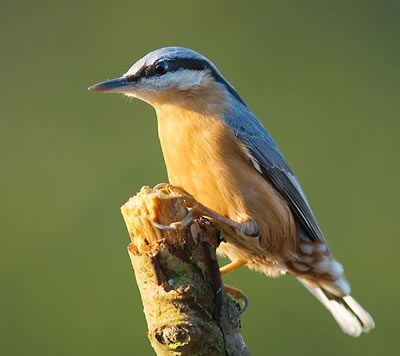Eurasian Nuthatch

Facts about creatures
- Home
- Animal Classification
- Animal Habitats
- Amphibians
- Arthropods
- Bats
- Birds
- Carnivorans
- Cetaceans
- Chordates
- Crustaceans
- Dinosaurs
- Diprotodonts
- Elephants
- Fish
- Golden Mole
- Insects
- Lagomorphs
- Mammals
- Mammal Teeth
- Marsupial Mole
- Metamorphosis
- Mollusks
- Primates
- Reptiles
- Rodents
- Ruminants
- Soricomorphans
- Tenrec
- Tetrapods
- Vertebrates
Eurasian Nuthatch
The Eurasian nuthatch is a small passerine bird that resembles a woodpecker in appearance and behavior.
Like woodpeckers, nuthatches spend most of their time on trees, where they hunt for food.
However, while woodpeckers probe for grubs inside trees, nuthatches hunt for insects and break open nuts. Nuthatches can walk down trees headfirst and across them horizontally; woodpeckers can only climb upwards.

The nuthatch’s toes differ from the toes of a woodpecker. The nuthatch has three toes in front and one in back. This arrangement is known as anisodactyly. The woodpecker has two toes in front and two in back, a condition known as zygodactyly.
While both the woodpecker and the nuthatch have long, dagger-shaped beaks, the nuthatch does not have the woodpecker’s long tongue.
Woodpeckers depend on their strong, stiff tails to balance on tree trunks. Nuthatches have shorter, more flexible tails. They depend on their claws for support.
The Eurasian nuthatch is gray on top, with a cinnamon-tinged fawn-colored underside. Its throat and the side of its face are white.
A chestnut patch can be found on each flank, extending up under the wing. This patch is darker in the male than in the female
The Eurasian nuthatch is mostly found in mature deciduous forests, often with oak, beech, sweet chestnut, hazel and hornbeam trees.
Nest
The Eurasian nuthatch builds its nest in natural cavities. These are usually holes within decaying trees. Sometimes, however, the nuthatch will build a nest in a space inside a little-used or abandoned building.
Most nests are within a few yards of the ground.
The nuthatch lays its eggs on the floor of the nest, on top of a layer of leaves or bark flakes.
The female incubates the eggs. When she leaves to get something to eat or drink, she covers the eggs with the bark flakes or leaves.